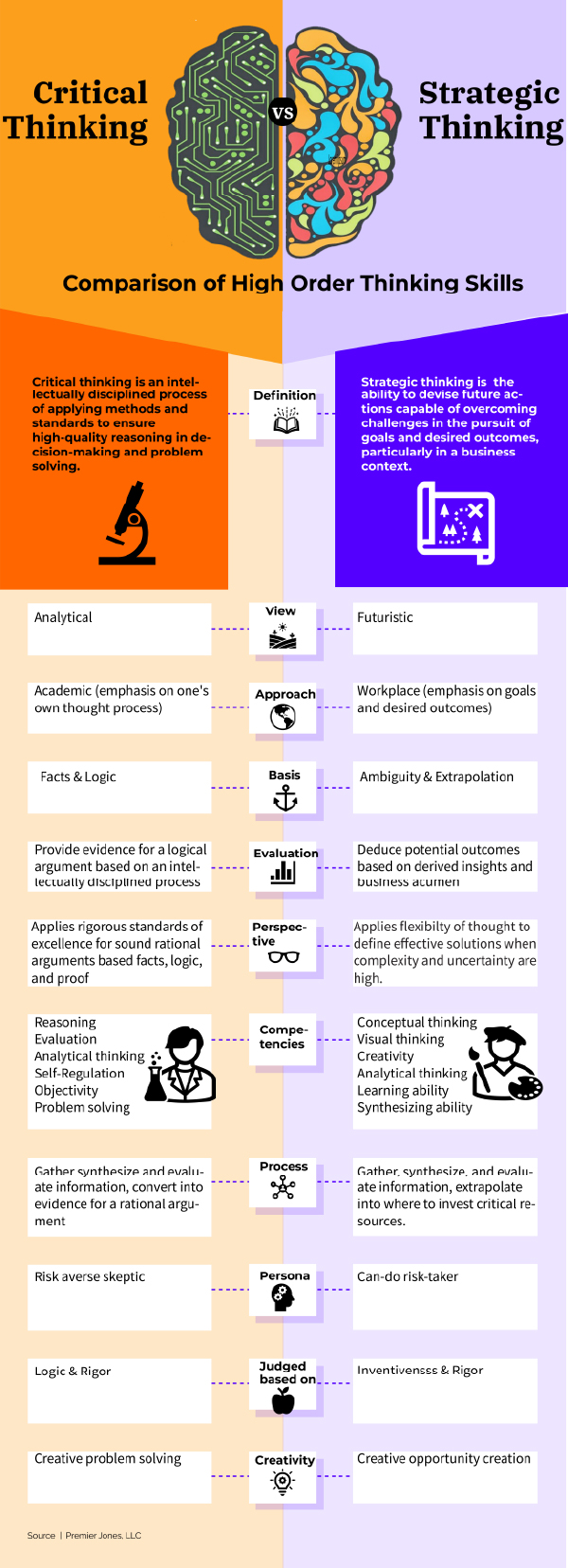
Managers solve complex problems and create opportunities. In order to perform these critical actions successfully, they must be able to go beyond recalling facts (aka lower level skills) to applying this knowledge and creating new solutions (aka higher order thinking or HOT). In this article, we will compare and contrast two types of higher order thinking, critical thinking and strategic thinking.
Traits in Common
In conducting my research for this article, I came across many perspectives and found myself at odds with much of it. As an R&D Engineer in Product Development, I studied the ins and outs of creating new technological solutions. And, as a Commercial Business Leader responsible for product strategy and revenue growth, I dealt with the challenges of creating new commercial solutions. Both critical thinking and strategic thinking are higher order thinking (HOT) skills. And, based on my real world work experience, critical thinking and strategic thinking have the following traits in common:
- Both seek to increase the probability of success and reduce risks.
- Both involve looking at a situation from different angles.
- Both involve gathering, analyzing, synthesizing, and analyzing information.
- Both apply reflective thinking aimed at deciding what to believe or what to do.
- Both are refined and validated by critical analysis to make sure that there are no gaps, bias, or oversights that would impact judgement.
So, then, what's the difference?
Traits that Distinguish
While both are critical to workplace success and have some overlap, the two ways of thinking have distinguishing traits as well.
Definitions
What is critical thinking?
Critical thinking is an intellectually disciplined process of applying methods and standards to ensure high-quality reasoning in decision-making and problem solving.
What is strategic thinking?
Strategic thinking is the ability to devise future actions capable of overcoming challenges in the pursuit of goals and desired outcomes, particularly in a business context.
A key difference between critical thinking and strategic thinking is that strategic thinking is focused on future actions whereas critical thinking is mostly focused on the mechanics involved in thinking clearly.
View Points
Another key difference is the focus or emphasis of the two methods. Critical thinking is focused on having the evidence needed to support a logical argument and making sure that the though process is disciplined and rational. Strategic thinking, on the other hand, is laser focused on finding ways to navigate through high ambiguity and complex situations in a way that delivers the best outcomes.
Competencies
When it comes to critical thinking, the central key competency is reasoning. Reasoning is supported by objectively evaluating and analyzing data in a manner that is rigorous enough to within scrutiny. Strategic thinking is also highly analytical in nature. And, the uncertainty of the future and big picture aspects of strategic thinking means that conceptual and visual thinking are essential competencies as well.
Contribution
In the workplace, some professions lend themselves to seek excellence in purely rational thought while others reward pushing the company towards its future aspirations. So, a common dynamic in the workplace is to have a commercial business leader who is responsible for business growth having highly developed critical thinking skills. These leaders must work several steps ahead in order to make sure that the company is prepared to and aligned with investing critical resources where needed. These leaders tend to take on the persona of a risk taker. Taking risks that pay off in big opportunities and success is the hallmark of an effective strategic thinker.
In the workplace, critical thinkers counterbalance strategic thinkers. Their thorough, pragmatic approach is called upon to find creative ways to solve problem. This persona tends to be very cautious and risk averse. Their unbiased, data-based review of situations helps to give the organization confidence in its ability to tackle challenges.
The contributions of both are essential to a company's success.
Critical and Strategic Thinking Connection
The role of strategic thinking and critical thinking are compared here to show the similarities and the differences. However, critical thinking is part of the strategic plan development process. For example, a strategic thinking session typically has two components. One part is idea generation, such as brainstorming. In this phase, critical judgment is suspended and creativity is encouraged. Once an idea forms and shows promise of achieving the desired outcome, then this plan of action is vetted and tested. In the workplace, different members of the cross functional team may find room for improvement. Senior managers may identify gaps overlooked previously. This feedback is then applied to refine the plan and the clarify the vision. With each iteration, the strategic plan becomes more actionable, gains support, and shapes up to be more likely to be successful. So, strategic thinking has a critical thinking component to it to help validate and refine its rationale.
Author Information
Felicia Littlejohn, Ph.D., is Learning and Development (L&D) professional, leadership coach, and former commercial business leader who empowers others to achieve their goals. Her work in leadership development, coaching, and strategy consulting has helped businesses, teams, and professionals to upskill, cultivate leadership potential, enhance performance, and overcome growth hurdles. Felicia is a Certified Professional Coach (C.P.C.) who holds a Ph.D. in Engineering, an M.B.A. in Marketing, and is currently pursuing an M.Ed. in Instructional Design.
